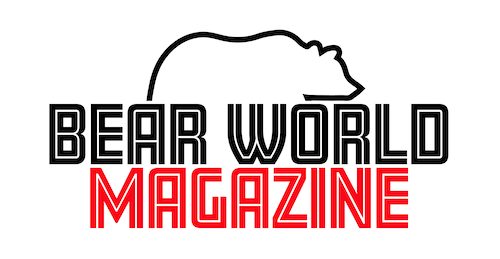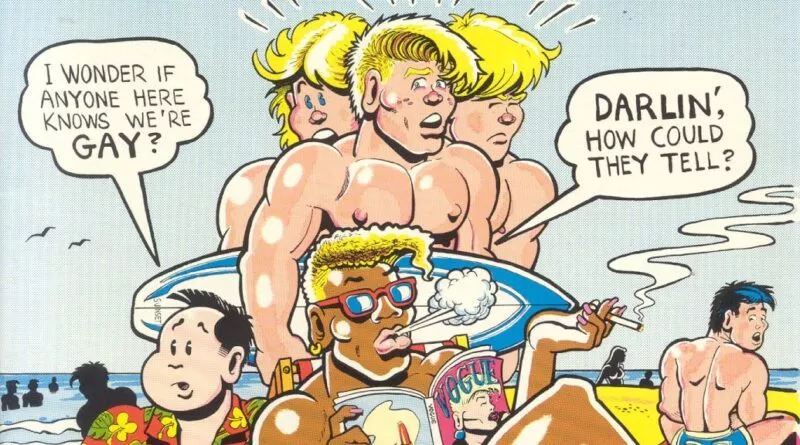Comics Corner – The Historic Importance of ‘Gay Comix’, Part 6
It is winter 1985, and after a shift in publisher from Kitchen Sink Press to Bob Ross, and under the editorship of Robert Triptow, Gay Comix has shifted to a quarterly production cycle. It’s a move that would provide four times the potential to showcase the queer artists, writers, and creators of the day. With Gay Comix #6, the anthology series now also has a more defined identity for itself, and a growing confidence in the material published in its pages and the themes it tackles.
For the most part, that’s a major positive. This issue features a plethora of talent telling stories exploring queer identities through lenses both mundane and metaphysical, and tones ranging from serious to farcical. It also sees the debut of important works from Howard Cruse and Jeff Krell, bringing in their characters from other publications in a show of Gay Comix’s growing standing. Sadly though, there’s one strip in the issue that, particularly in a present day reading, feels very uncomfortable…
This is the latest in a series of retrospectives looking at the pivotal underground publication Gay Comix. You can find #1 here, #2 here, #3 here, #4 here, and #5 here.
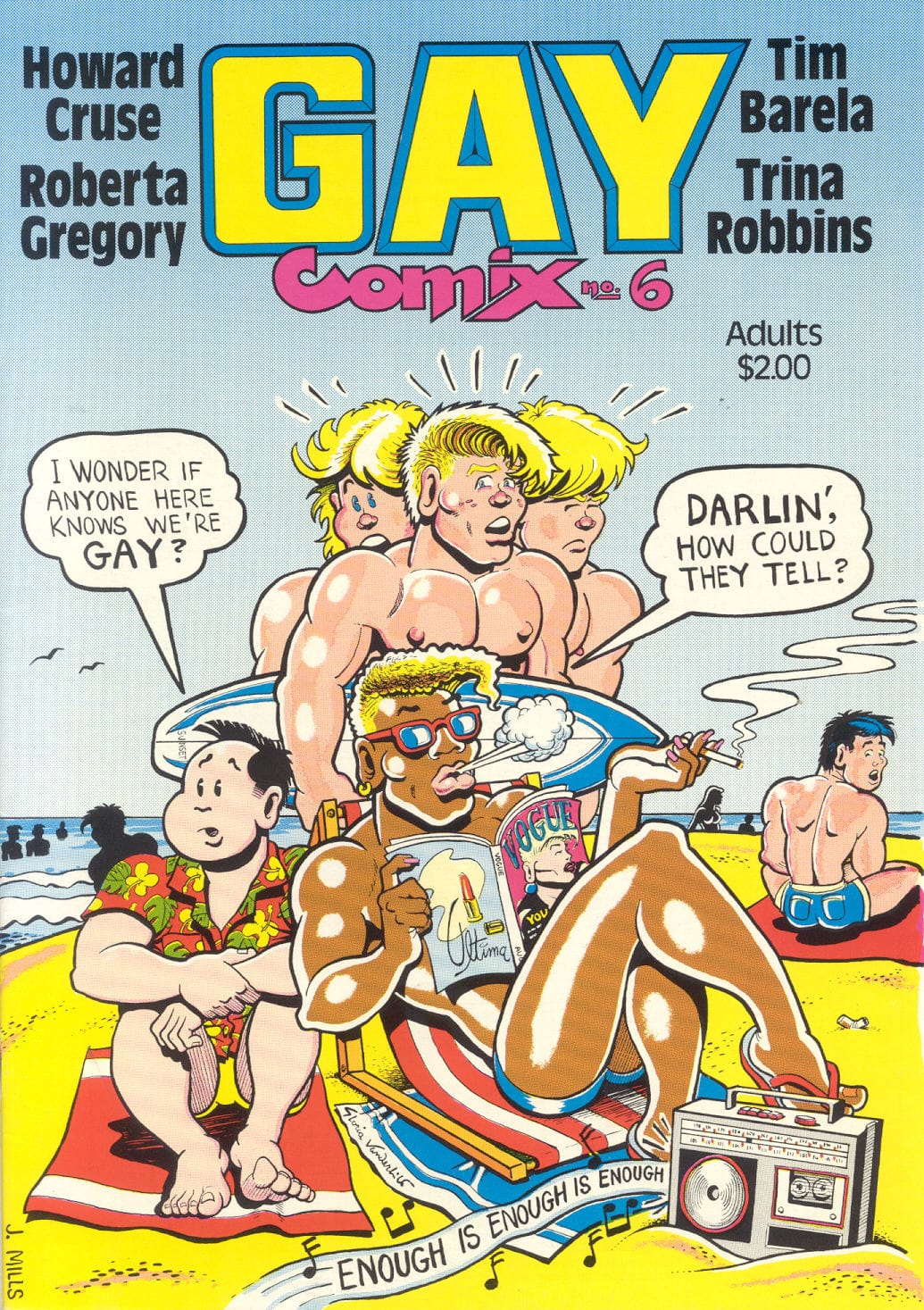
With 38 years of hindsight, it’s perhaps the first main strip, Trina Robbins’ “Tommy Teene” that remains the most daring. Similar to some of the entries found in Gay Comix #4, this is an homage to the mainstream fashion and romance comics of the 1950s and ‘60s, particularly Katy Keene – if the title alone didn’t give it away – and Millie the Model. Like its inspiration, Tommy Teene is a teenage model, and the story itself is a lighthearted comedy, with the lead character facing a sartorial crisis ahead of a key social event.
Unlike its chief influences, Tommy is “only sixteen but he’s a teenage queen”, which means embracing extremely effeminate – and arguably camp – behaviour. When he learns his rival will be wearing the latest couture from Issey Miyake to the high school sock hop – another nod to the low-stakes tribulations of the romance comics genre – he throws a massive strop and spends five hours trying on alternative outfits, while his onlooking parents lament that it’s “just a phase”.
Although the strip may seem to draw overly on stereotypes of gay men, it’s also hard to understate how groundbreaking it was to even acknowledge the existence of queer youth in the mid-1980s. Without even addressing sex as an act – short of Tommy rejecting the amorous advances of obvious female love interests – Robbins establishes that gay kids exist, and contrary to expectations, it’s never just a phase.
The strip also showcases Robbins’ love of romance comics as a medium. Tommy’s quick-change fashion montage, with every outfit credited to readers, is a nod to the aforementioned likes of Katy Keene, where fans would submit designs for the lead characters to wear (although here they have suspiciously familiar names such as “Mr O. Wilde” and “Billy Burroughs”). “Tommy Teene” showcases a mastery of the form that would serve Robbins well – a year later, she would create Misty at Marvel’s Star Comics imprint, a loose sequel to Millie the Model where the original lead was now managing her own modelling agency, with her niece Misty following in the family business.
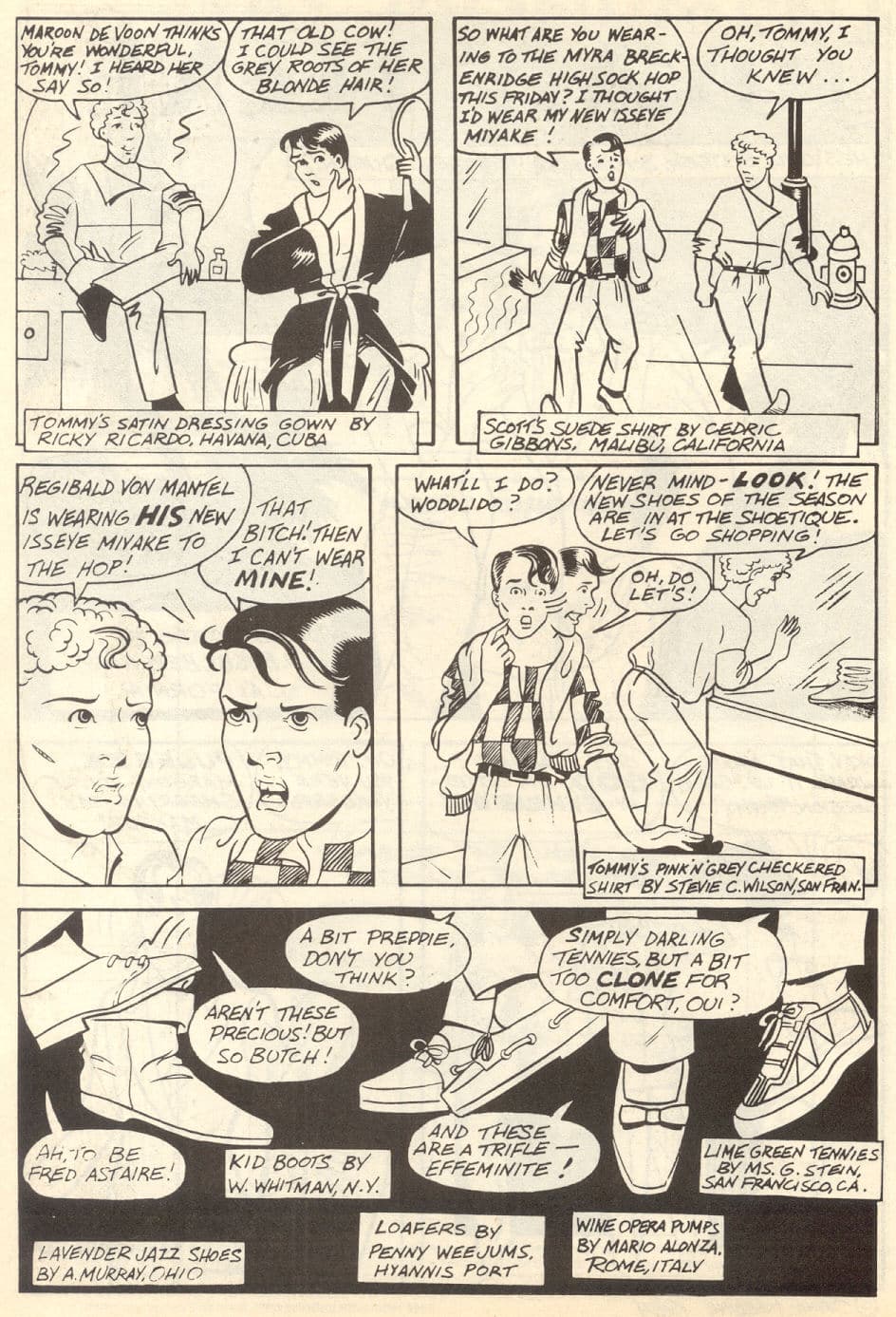
Leslie Ewing’s “Terminal Lesbian Couple-itus” shifts focus, with a teasing look at lesbian relationships. A two-pager following two women, Martha and Candy, it’s almost a “how to” poking fun at the idea of lesbians moving too fast. After meeting at a club, where Candy says she’d “love to dance and maybe move in with you”, Ewing points out the pitfalls lesbian couples can fall victim to, before offering a few ideas to keep things fresh and stave off lesbian bed death. Advice includes dropping overly saccharine nicknames, keeping the finances separate, and never mixing laundry – all good rules even now, lesbian or not!
Regular Gay Comix contributor Tim Barela also returns with another chapter of his “Leonard & Larry” strip. Titled “Lovers and Other Uninvited Guests”, it sees the eponymous duo hosting a dinner party, but Larry and Leonard have each invited very different guests – while Leonard has his ex Dennis and his new boyfriend Leon coming over, Larry’s ex-wife Sharon and new fianceé Gordon are also making an appearance! It’s a sitcom in comic strip form, and although the set-up is familiar and the culture clash misunderstandings predictable – Gordon is a straitlaced moral majority type, Dennis and Leon are outrageously open in discussing their recent hook-ups, and Larry is stuck wearing leather biker gear – Barela successfully plays it all for laughs. Each panel is packed with jokes, while the ending takes a swerve that subverts expectations over Gordon’s portrayal to that point.
Visually, Barela continues to be one of the most skilled artists to grace Gay Comix’s pages, the personalities of every character shining through as much from Barela’s wonderfully expressive faces as through his trademark zippy dialogue. However, although Leonard & Larry gets a five-page outing this issue, it still suffers from the density that hurt issue four’s “Revenge of the Yenta”. It’s a testament to Barela’s storytelling skills that there’s still a fantastic sense of movement between panels, even as speech bubbles dominate the real estate.
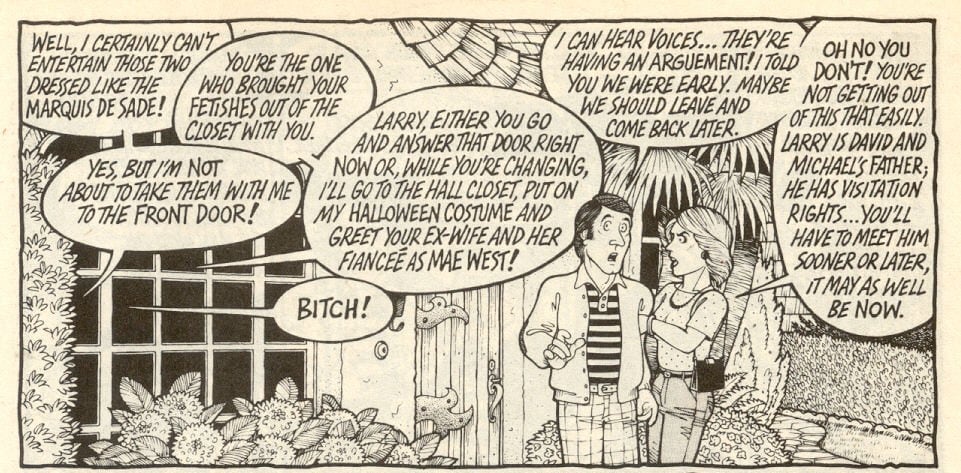
Beyond the gags though, “Lovers and Other Uninvited Guests” also provides an important bit of visibility in establishing that Larry and Sharon had kids before they divorced, and that Larry still has visitation rights. Like “Tommy Teene” acknowledging that queer kids exist, the simple recognition of gay parents feels hugely significant for 1985. Yes, Gay Comix was largely an underground title to this point, and there’s an element of ‘preaching to the choir’ – of course gay readers know gay parents exist, right? – but even the understated way in which it’s dealt with here feels game changing. It’s also pleasant to see that Larry and Sharon remain, at least to some extent, friends despite their divorce and Larry’s coming out – a hugely progressive depiction.
Roberta Gregory’s sci-fi tinged “Acute Observation” is perhaps the most thought provoking entry this issue though. Two celestial beings – it’s largely up to the reader to determine if they’re aliens, angels, or something else entirely – take a look at humanity and all our foibles, with the younger of the two, Heraphet, sent to Earth to observe more closely. Materialising on a beachfront, Heraphet is crashed into by Lupe, a skateboarder – and lesbian – who ends up unwittingly introducing the outsider to our highs and lows as a species.
Gregory uses Heraphet’s perspective to brilliantly skewer our penchant for dichotomies and binaries, be they sexual, gender, or even theological in nature. Heraphet, who possesses an outwardly conventionally feminine form, can’t fathom why some human pairings of “similar forms” are met with derision, or why “the individuals most universally and systematically excluded refer to themselves as the HAPPY ONES”, or how even our “metaphysical paradigms” – at least those reflected by Evangelical Christians protesting outside Pride – present only a duality of heaven or hell. It’s a pointed look at how humanity divides itself along lines that, were we able to step outside our own experiences, we would see are entirely artificial.
More powerfully, the six-page strip doesn’t just boil down to “homophobia bad”. Gregory also uses Heraphet to cast an external eye on the LGBTQ+ community as a whole, pointing out how baffling and counter-intuitive it is to see queer factionalism creating smaller divisions within an already oppressed community. Walking through Pride, Heraphet’s ability to scan thoughts leads to her being overwhelmed with shallow tribalism – lesbians complaining of too many men, gay men complaining of too many women, bi people scorned because they started dating members of the opposite sex, gender-nonconforming people being welcomed and condemned in equal measure, and every subgroup thinking another gives the whole community a bad name. Nearly four decades on from the story’s original publication, it remains an urgent and important wake-up call that LGBTQ+ people must stand together.

Jeff Krell’s “Jayson Goes Home” then takes readers from the metaphysical to the material world, with the titular Jayson Callowhill heading to his rural home town for a high school reunion, with his best friend Arena in tow. Krell had created the character of Jayson in 1982, with the strip going on to be a regular feature in the Philadelphia Gay News, exploring queer life in the big city through the eyes of its small-town protagonist. This strip marked Jayson’s first appearance in Gay Comix, and the story being a brand new outing.
While Jayson was inspired by Krell’s love for classic Archie comics, and has itself been called “the gay Archie”, this particular strip skews older – more Riverdale than The Archie Show, with Jayson and Arena confronted with the shocking racism, homophobia, antisemitism, and bigoted language of Pennsylvania Dutch Country where Jayson – and Krell, in real life – grew up. However, very much like Archie, Jayson and Arena prove unflappable, dancing around the hyper-conservative townies and their outdated, oppressive moralising with quick wits and sharp words.
It’s easy to see how Jayson would go on to earn those comparisons to Archie though. Krell’s cartooning style is heavily influenced by the likes of Dan DeCarlo, arguably the Archie Comics artist who defined the popular characters’ aesthetic for a generation, while his page flows echo the pacing of conventional Archie strips. Jayson’s introduction to the pages of Gay Comix here would be a hit – expect to see more of the Gay Archie in future instalments.
Then there’s the aforementioned uncomfortable read – “The Sparkle Spinsters: Stains on the Sofa” by Kurt Erichsen. A sort of gay(er?) take on The Golden Girls – although per Erichsen’s copyright, it actually pre-dates the classic sitcom by a year – it follows three gay men sharing a house, with the oldest – referred to only as The Duchess – complaining about the younger two, Vernon and Lee, leaving a “mess” after they’ve had partners over. What starts as a bit of gross-out comedy takes a swerve into unsettling territory when Vernon and Lee decide The Duchess is simply grumpy because he’s not “gotten lucky”, and so set him up with Tom, a paperboy who conveniently arrives trying to sell subscriptions.
The rest of the strip is a running ‘joke’ where The Duchess has actually fallen for Tom, leading Vernon and Lee to scheme to break them up again, fearing they might lose their comfortable lives in The Duchess’ house if the pair stayed together. While there are a few more gross-out gags – mixing fish oil in with the house’s shared lube dispenser to ruin the mood with a foul stench, for instance – none of them really land because the question of Tom’s age makes everything extremely discomfiting.
The fact that the only thing we know about him is that he’s a paperboy makes things all the more unsettling. It’s even worse that when Vernon says “it will be child’s play” to find a “cute young hunk” for The Duchess, Lee follows with “here comes a child for him to play with” when Tom appears at their door. While a charitable reading might see it as simply a play on the extreme and obvious age difference between The Duchess and Tom, Tom’s age is never given. He’s also drawn as the shortest and slightest of the characters (in other words: a twink), and his appearances through the rest of the strip typically have him held possessively by The Duchess. On top of the fact that paperboys are rarely consenting adults, it makes for disturbing implications. Let’s just assume Tom is a college freshman with a job he’s typically too old for, and move on.
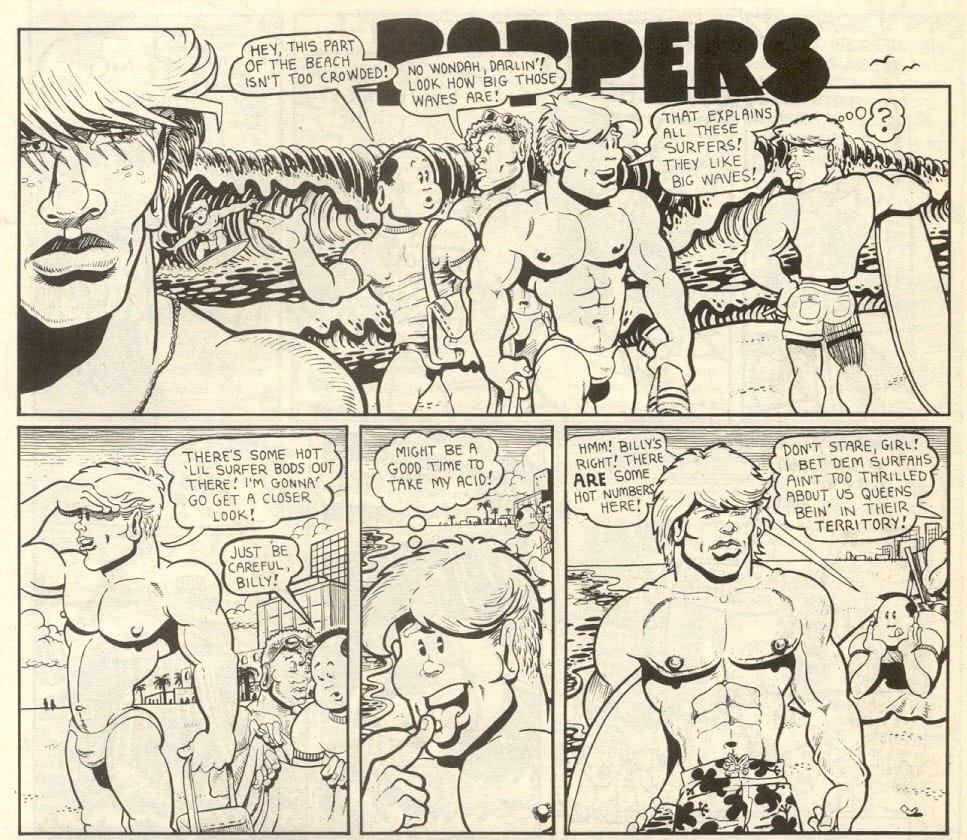
Thankfully, the rest of this issue of Gay Comix had some fun strips to distract from “The Sparkle Spinsters”. There’s “The Elves and the Leathermaker”, by Michael Goldberg and Richard Cornwell, offering a twist on the fairy tale “The Elves and the Shoemaker”, swapping out footwear for fetish gear and some BDSM-themed jokes. Elsewhere, a one-pager for Joe Sinardi’s “Gideon and Friends” serves some animalistic humour as Gideon’s (male) dog finds a boyfriend, while P Marcel’s “Night of the Hunter” offers an anthropomorphised recreation of a bad night out on the gay scene – anyone who’s ever gone home with the wrong person will find it painfully accurate.
A new entry in Jerry Mills’ ongoing “Poppers” series sees the familiar gang of overly-muscled himbos on a trip to the beach, where an acid-tripping Billy unwittingly surfs a tsunami, winning approval from a group of straight jocks. It’s a fast and punchy two-pager, packed with gags, and serves as the basis for the issue’s striking front cover. The back cover marks another first for Gay Comix though, with the anthology’s first appearance of Howard Cruse’s “Wendel”. Like Krell’s Jayson, Cruse had created the character years earlier, with Wendel and his boyfriend Ollie appearing in strips for The Advocate from 1983 onwards, serving up satirical shorts snapping at current events. Here, a grocery shopping trip turns into a dig at the then-emerging trend for brands to push their “family values” credentials, all using buzzwords to appeal to the conservative right – only to find no product fully meets progressive expectations. Who ever thought a jokey collection of gay comics would serve as a reminder that there’s no ethical consumption under capitalism?
After the lackluster issue five, Gay Comix #6 felt like a return to form – barring its most unfortunate and most poorly aged entry in Erichsen’s strip. The anthology was now firmly into its quarterly publishing schedule, and as future issues will show, it would go from strength to strength.
This article was originally published on our sister site, Gayming Magazine.
